Fiberglass windows come of age
by brittney_cutler | March 4, 2022 12:00 pm
 [1]
[1]Fiberglass has existed since engineer and inventor Games Slayter of the Owens-Illinois Glass Company patented “glass wool” for thermal building insulation in 1933 with full commercial production going to market in 1936. Many are familiar with fiberglass being used in cars and boats, but the manufacturing process varies significantly. Cars and boats use a conventional ‘chopped strand mat’ process in which fibers are laid randomly across each other into a mold and held together by a binder or ‘gel coat.’ Fiberglass has evolved over the years from being used in boats and bathtubs to being trusted by the National Aeronautics and Space Administration (NASA) for use on spacecraft[2].
As a result of its impressive weight-to-strength ratio, fiberglass is structurally sound with a natural thermal break, making it a perfect material for windows and doors. Fiberglass is an inert, stable material and does not off-gas material like polyvinyl chloride (PVC), making it better for the environment than other options.
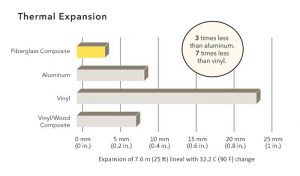 [3]
[3]Fiberglass windows are generally made through a pultruding process combining roving and matting, followed by an injection of resin, all while being pulled through a die to create a shape or profile. Pultrusion patents were introduced in 1946 and have been commercially produced since 1952[4]. The thermoset process produces a material that will not break down when exposed to elements or lose its shape in extreme hot and cold temperatures. Once it is molded and cured by heat, the molecules crosslink and it becomes a solid, irreversible substrate. High ambient temperatures will not melt, warp, or become misshapen like some thermoplastics.
Finishes
Some fiberglass manufacturers may offer field-finishing; however, pultrusions are generally factory finished by powder coating, painting, or a cap stock covering in a variety of colors to provide a long-term, durable finish. Most of these finishes are maintenance-free and resistant to corrosion, blistering, peeling, chipping, and chalking for lasting durability and aesthetics.
Coatings for thermoset fiberglass profiles use the American Architectural Manufacturers Association (AAMA) 623, 624, 625 series for evaluating color uniformity, specular gloss retention, impact resistance, color fading, and other attributes related to weathering and aesthetics:
AAMA 623: Performance Requirements and Test Procedures for Organic Coatings on Fiber Reinforced Thermoset Profiles;
AAMA 624: Performance Requirements and Test Procedures for High Performance Organic Coatings on Fiber Reinforced Thermoset Profiles; and
AAMA 625: Performance Requirements and Test Procedures for Superior Performance.
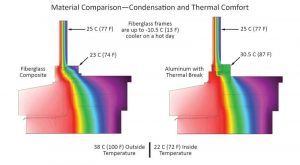 Organic coatings on fiber reinforced thermoset profiles
Organic coatings on fiber reinforced thermoset profiles
These AAMA standards define the capabilities of the finish and can be viewed as good-better-best from a performance perspective. Typical fiberglass finishes meet the AAMA 623 or 624 standards and, as it shifts from 623 to 624, the performance requirements and longevity expectations of the coating increase. The Fiberglass Material Council (FMC) has continued to evaluate and update the specifications—much of which is based on variances resulting from different coating colors. The goal is to keep specifications up to date to ensure the industry stays on the cutting edge.
Fiberglass versus vinyl
Fiberglass testing shows it is 10 times stronger than vinyl, based on the tensile strength test at peak load t/m² (lbf/in2). As a result, fiberglass can provide thinner profiles not only in the frames, but also in mullions. Typically, fiberglass windows can use 12.7 mm (0.5 in.) or 25.4 mm (1 in.) structural mullions that keep total widths at a minimum, which is more comparable to aluminum sightlines than vinyl.
Since vinyl lacks integral strength, overall sizes are constrained. Frames and mullions need to be wider and reinforced with aluminum or steel so there is much less visible glass in the openings. Many vinyl windows cannot be mulled with a four-way joint—that is, four windows mulled together into a composite window.
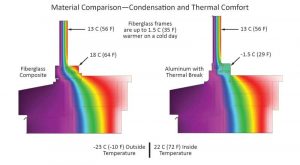 A single fiberglass fixed window can be manufactured up to 6.5 m2 (70 sf). The thinner profiling enables fiberglass to achieve greater sightlines and more visible glass, which continues to be a design trend in the marketplace.
A single fiberglass fixed window can be manufactured up to 6.5 m2 (70 sf). The thinner profiling enables fiberglass to achieve greater sightlines and more visible glass, which continues to be a design trend in the marketplace.
With the popularity of large expanses of glass and labor availability challenges, mulling capabilities are an important consideration when choosing windows and doors. Due to material and manufacturing limitations of vinyl and vinyl composite windows, factory mulling options are often more limited than with fiberglass. Sleeker factory mulled combinations with reinforcing mullions are available with fiberglass windows and offer greater flexibility in design options.
Expansion and contraction and impact on durability
When comparing thermal efficiency, both materials offer similar thermal performance for U-factors and solar heat gain, however, fiberglass has a better expansion and contraction coefficient than vinyl (also referred to as PVC or plastic) which can help with product durability. Vinyl frames expand and contract more than fiberglass with temperature changes. Fiberglass shows the lowest thermal expansion and contraction (see Figure 1, page 9) among the most popular window materials.
Since fiberglass is partially made from glass, the frames expand and contract along with the insulated glass units (IGUs) to provide excellent protection against seal failure and provide long term durability.
Oh, hail!
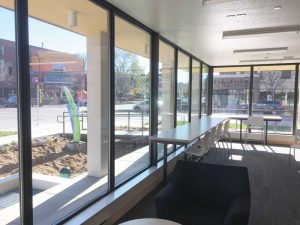 [5]
[5]Vinyl and wood/plastic composite windows can struggle to withstand hits from large hail (ASTM D256 Standard Test Method for Determining Impact Resistance of Plastics). These window materials are difficult to repair and usually must be replaced because of potential water and air infiltration. In some cases, the sash may be replaced if only it is damaged, but the main frame survived unscathed.
Fiberglass has a high impact threshold and resists damage from a direct hit, but if damaged, can be repaired so replacement is not necessary. Fiberglass does not get more brittle in colder temperatures because of the pultrusion process. In fact, fiberglass changes little from -1.1 to 65.5 C (30 to 150 F) (ASTM E831, Coefficient of Linear Thermal Expansion).
Cost considerations for fiberglass and vinyl
There are lower cost vinyl windows in the market serving the purpose of filling an opening and providing views, daylight, and ventilation. However, lower cost vinyl windows lack the ultraviolet (UV) protection, structural integrity, and durability, which higher quality windows offer.
Lower cost vinyl windows used in multifamily projects will need to be replaced sooner than fiberglass windows. In the author’s experience, these lower cost windows have had to be replaced in as little as 10 years with most needing to be replaced within 15 years. These replacement costs are much higher than the initial cost of material, labor, and installation. Fiberglass is optimized for low-maintenance and longevity, making it a perfect fit for owners holding properties and looking to maximize their long-term return on investment (ROI).
Fiberglass versus aluminum
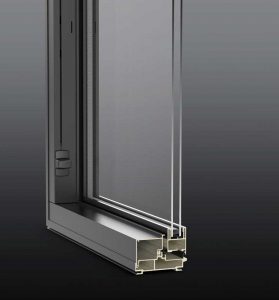 [6]
[6]Aluminum windows gained popularity after World War II and rivaled wood windows by the 1970s. While maintaining popularity, aluminum windows are notorious for their lack of energy efficiency. Despite advances in spacer and thermal break technology, it takes triple-pane aluminum windows to match dual-pane fiberglass windows for U-factors and solar heat gain coefficient (SHGC) values. There is also a substantial difference in condensation resistance (see Figures 2 and 3).
Expansion and contraction
As far as how fiberglass compares to aluminum, the former has less than a third of the thermal expansion of aluminum and less than 0.02 percent of the thermal conductivity of aluminum. Aluminum has one of the highest thermal expansion coefficients of any metal type (ASTM E831-19, Standard Test Method for Linear Thermal Expansion of Solid Materials by Thermomechanical Analysis). Over time, this can lead to increased maintenance, cause stress to sealants and fasteners, and may lead to faster air and water infiltration.
Performance class and grade
Many fiberglass windows are rated at CW-PG50 or above. Performance class (commercial [CW]) and performance grade 50 means one can get floor-to-ceiling fixed windows with thin mulls of 13 or 25 mm (0.5 or 1 in.) aluminum, depending on the overall size of the window. Based on American Society of Civil Engineers (ASCE) 7, Minimum Design Loads and Associated Criteria for Buildings and Other Structures, structural performance calculations show fiberglass windows can exceed 30 stories in most areas. This matches the look of aluminum and is something that cannot be achieved with lower performance vinyl.
Fire rating
Fiberglass windows are generally not fire rated. Always check with the window manufacturer on fire rating for frames and glazing.
Installation
Fiberglass windows can usually be installed in similar fashion to aluminum windows. Options include nail flange (fin), clips, screw through the frame, receptors, and additional trim accessories such as brickmould and frame expanders; there are plenty of options for any condition.
Shadow boxes
To meet the needs of Passive House and other energy-saving initiatives, exterior solar shading is increasing in popularity. Shadow studies are being widely used not only for impact of the physical obstruction of the building, but also for controlling solar heat gain. Depending on the amount and location of fenestration, reductions in annual cooling energy consumption of five to 15 percent have been reported[7]. Custom extrusion capabilities allow sunshades and shadowboxes to be added to the rough opening and integrated with the window frame.
The detail drawing shows an extruded aluminum shadow box integrated with a window installed above 101.6 mm (4 in.) of mineral wool with a fiberglass support bracket. Since fiberglass is naturally thermally broken, thermal bridging is kept to a minimum.
Storefronts and window walls
Fiberglass windows can reach up to 6.5 m2 (70 sf) in a fixed frame and can be factory mulled and field mulled into storefront and window wall configurations. Due to improved energy efficiency, fiberglass frames can stay almost room temperature even on cold days and condensation resistance is superior. Triple pane is available up to 4.6 m2 (50 sf) and offers even better U-factors.
With glazing pre-installed into the frames at the factory and easy-to-install field mullions, installation for fiberglass storefront windows can save costs involved with panning, field glazing, and mullion installation.
Cost comparisons
Fiberglass frames are competitive with aluminum frames, though it is difficult to directly compare prices due to wide swings in quality and location. One important consideration is fiberglass frames are factory glazed and factory mulled when possible (depending on size—these storefront windows are 4.6 m2 each and factory mulled two wide), considerable savings can be realized when comparing installation costs of site glazing aluminum frames.
Glazing innovation
There are many window manufacturers using all types of materials and glazing science, so innovation and cost savings are the driving force for gaining a competitive advantage. One new development is a new style of operator for casements and awnings.
For years, casements and awnings have opened and closed with a crank. Now, a totally new sliding style of operation has been introduced that also meets the difficult 2.3 kg (5 lb) operating force Americans with Disabilities Act (ADA) requirement up to certain sizes. With the slider mechanism in the jamb, it does not interfere with shades and blinds opening or closing.
Summary
While similar in thermal efficiency, fiberglass frames are stronger and more durable than vinyl frames. While generally more expensive than vinyl, the strength of fiberglass allows for larger frame sizes, narrow mulls, and storefront capabilities.
Fiberglass window frames offer the strength, durability, and narrow sightlines of aluminum but are more thermally efficient, smoothing out heating and cooling peak loads, and providing better condensation resistance. Similar in cost to mid-priced aluminum windows, significant savings may be realized on labor costs when installing factory glazed and mulled fiberglass frames.
Fiberglass window frames are rapidly gaining popularity in commercial projects from multifamily to hospitality and new innovations in operating hardware make them attractive for senior livings. Offering flexible design and installation options, high-performance structural and thermal attributes, and sleek, contemporary sightlines, fiberglass windows make a great alternative to vinyl and aluminum windows and are worth considering on future projects.
Authors
- [Image]: https://www.constructionspecifier.com/wp-content/uploads/2022/03/IMP_Commercial_IronClad_PASS_20191003-8344.jpg
- spacecraft: http://www.compositesworld.com/articles/composites-in-space(2).
- [Image]: https://www.constructionspecifier.com/wp-content/uploads/2022/03/Figure-1.jpg
- 1952: http://www.compositesworld.com/articles/brandt-goldsworthy-composites-visionary.
- [Image]: https://www.constructionspecifier.com/wp-content/uploads/2022/03/Fiberglass-Storefront-Windows.jpg
- [Image]: https://www.constructionspecifier.com/wp-content/uploads/2022/03/Sliding-operator-picture.jpg
- reported: http://www.wbdg.org/resources/sun-control-and-shading-devices
Source URL: https://www.constructionspecifier.com/fiberglass-windows-come-of-age/
 George Ramsay, CSI, CDT, is the national architectural solutions consultant at Pella Corporation. Ramsay has more than 20 years of experience in building materials, specializing in working with the architectural and design community. He works around the country providing technical and design assistance, specification writing, and guidance, and is focused on making architects, and specification writers, fenestration challenges less painful. Ramsay served as president of the CSI-MSP Chapter 2016-2017 and was on the board of directors for five years. He has served on various committees locally and regionally over the last 15 years for CSI-MSP and is currently treasurer for the North Central region. Ramsay is a graduate of the College of Saint Scholastica in business management with honors.
George Ramsay, CSI, CDT, is the national architectural solutions consultant at Pella Corporation. Ramsay has more than 20 years of experience in building materials, specializing in working with the architectural and design community. He works around the country providing technical and design assistance, specification writing, and guidance, and is focused on making architects, and specification writers, fenestration challenges less painful. Ramsay served as president of the CSI-MSP Chapter 2016-2017 and was on the board of directors for five years. He has served on various committees locally and regionally over the last 15 years for CSI-MSP and is currently treasurer for the North Central region. Ramsay is a graduate of the College of Saint Scholastica in business management with honors. Bryan Warring is the product marketing manager, Impervia fiberglass at Pella. With more than 13 years in the building material and construction industry, Warring’s experience is multi-faceted; it has spanned areas of the industry including retail store management, key account management, sales management, supply chain, and category management. He joined Pella in 2020 to take on the new challenge of leading and driving the Impervia fiberglass strategy. Warring graduated from Illinois State University in 2008 with a degree in marketing and earned a dual MBA in marketing and operations management from Regis University.
Bryan Warring is the product marketing manager, Impervia fiberglass at Pella. With more than 13 years in the building material and construction industry, Warring’s experience is multi-faceted; it has spanned areas of the industry including retail store management, key account management, sales management, supply chain, and category management. He joined Pella in 2020 to take on the new challenge of leading and driving the Impervia fiberglass strategy. Warring graduated from Illinois State University in 2008 with a degree in marketing and earned a dual MBA in marketing and operations management from Regis University. Jaron Vos is the manager of corporate architectural solutions team at Pella. Vos holds a bachelor of science in construction engineering and has assisted architects, contractors, and consultants with their fenestration application needs for 18 years.
Jaron Vos is the manager of corporate architectural solutions team at Pella. Vos holds a bachelor of science in construction engineering and has assisted architects, contractors, and consultants with their fenestration application needs for 18 years.